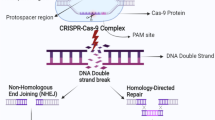Abstract
A review was conducted over the current achievements in the area of site-specific recombinases (SSR) and their applications for manipulations with pro- and eukaryotic genomes. The principles of SSR functioning and the types of genetic rearrangements catalyzed by SSR were analyzed. The examples given in this review show the SSR potential to solve a wide range of basic and practical problems. To use different methods for solving these problems, however, would be more difficult or even impossible. The main directions for further developing the technology of site-specific recombination are the following: the use of SSR for a wider range of biological systems; generation of the SSR, which are characterized by strictly controlled expression in space and time; and the search for recombinases with new substrate specificity.
Similar content being viewed by others
References
Sambrook, J., Fritsch, E.F., and Maniatis, T., Molecular Cloning: A Laboratory Manual, New York: Cold Spring Harbor Lab., 2001.
Mardis, E.R., Next-Generation DNA Sequencing Methods, Annu. Rev. Genom. Hum. Genet., 2008, vol. 9, pp. 387–402.
Wheeler, D.A., Srinivasan, M., Egholm, M., et al., The Complete Genome of an Individual by Massively Parallel DNA Sequencing, Nature, 2008, vol. 452, pp. 872–876.
Bentley, D.R., Balasubramanian, S., Swerdlow, H.P., et al., Accurate Whole Human Genome Sequencing using Reversible Terminator Chemistry, Nature, 2008, vol. 456, pp. 53–59.
Wang, J., Wang, W., Li, R., et al., The Diploid Genome Sequence of an Asian Individual, Nature, 2008, vol. 456, pp. 60–65.
Yu, B.J. and Kim, C., Minimization of the Escherichia coli Genome using the Tn5-Targeted Cre/LoxP Excision System, Meth. Mol. Biol., 2008, vol. 416, pp. 261–277.
Sadowski, P., The Flp Recombinase of the 2-Mm Plasmid of Saccharomyces cerevisiae, Prog. Nucl. Acids. Res. Mol. Biol., 1995, vol. 51, pp. 53–91.
Gidoni, D., Srivastava, V., and Carmi, N., Site-Specific Excisional Recombination Strategies for Elimination of Undesirable Transgenes from Crop Plants, In Vitro Cell Dev. Biol. Plant., 2008, vol. 44, pp. 457–467.
Zhang, Y., Liu, H., Li, B., Zhang, J.T., Li, Y., and Zhang, H., Generation of Selectable Marker-Free Transgenic Tomato Resistant to Drought, Cold and Oxidative Stress using the Cre/LoxP DNA Excision System, Transgenic Res., 2009 (doi: 10.1007/s11248-009-9251-6).
Moravcikova, J., Vaculkova, E., Bauer, M., and Libantova, J., Feasibility of the Seed Specific Cruciferin C Promoter in the Self Excision Cre/LoxP Strategy Focused on Generation of Marker-Free Transgenic Plants, Theor. Appl. Genet., 2008, vol. 117, pp. 1325–1334.
Branda, C.S. and Dymecki, S.M., Talking About a Revolution: The Impact of Site-Specific Recombinases on Genetic Analyses in Mice, Developmental Cell, 2004, vol. 6, pp. 7–28.
Schweizer, H.P., Applications of the Saccharomyces Cerevisiae Flp-FRT System in Bacterial Genetics, J. Mol. Microbiol. Biotechnol., 2003, vol. 5, pp. 67–77.
Wild, J., Sektas, M., Hradecna, Z., and Szybalski, W., Targeting and Retrofitting Pre-Existing Libraries of Transposon Insertions with FRT and OriV Elements for In-Vivo Generation of Large Quantities of Any Genomic Fragment, Gene, 1998, vol. 223, pp. 55–66.
Zhang, Y., Buchholz, F., Muyrers, J.P.P., and Stewart, A.F., A New Logic for DNA Engineering using Recombination in Escherichia coli, Nat. Genet., 1998, vol. 20, pp. 123–128.
Sharan, S.K., Thomason, L.C., Kuznetsov, S.G., and Court, D.L., Recombineering: A Homologous Recombination-Based Method of Genetic Engineering, Nat. Protocols, 2009, vol. 4, pp. 206–223.
Bron, P.A., Grangette, C., Mercenier, A., de Vos, W.M., and Kleerebezem, M., Identification of Lactobacillus plantarum Genes That Are Induced in the Gastrointestinal Tract of Mice, J. Bacteriol., 2004, vol. 186, pp. 5721–5729.
Jackson, R.W. and Giddens, S.R., Development and Application of in Vivo Expression Technology (IVET) for Analyzing Microbial Gene Expression in Complex Environments, Infect. Disorders-Drug Targets, 2006, vol. 6, pp. 207–240.
Sharma, N., Moldt, B., Dalsgaard, T., Jensen, T.G., and Mikkelsen, J.G., Regulated Gene Insertion by Steroid-Induced C31 Integrase, Nucleic Acids Res., 2008, vol. 36, pp. 1–12.
Luzhetskyy, A., Fedoryshin, M., Gromyko, O., et al., IncP Plasmids Are Most Effective in Mediating Conjugation between Escherichia coli and Streptomycetes, Russ. J. Genet., 2006, vol. 42, pp. 476–481.
Keravala, A. and Calos, M.P., Site-Specific Chromosomal Integration Mediated by C31 Integrase, Meth. Mol. Biol., 2006, vol. 435, pp. 165–173.
Thomason, L.C., Calendar, R., and Ow, D.W., Gene Insertion and Replacement in Schizosaccharomyces pombe Mediated by the Streptomyces Bacteriophage C31 Site-Specific Recombination System, Mol. Genet. Genom., 2001, vol. 265, pp. 1031–1038.
Fedoroyshin, M., Petzke, L., Welle, E., et al., Marker Removal from Actinomycete Genomes using Flp Recombinase, Gene, 2008, vol. 213, pp. 114–119.
Fedoryshin, M., Welle, E., Bechthold, A., and Luzhetskyy, A., Functional Expression of the Cre Recombinase in Actinomycetes, Appl. Microbiol. Biotechnol., 2008, vol. 78, pp. 1065–1070.
Blume, Ya., Sivolap, Yu., Rudii, R., and Sozinov, O., New Wave of “Green Revolution:” Prospects of Use of Advances in Biotechnology and Genomics in Ukraine, Visn. NAN Ukraini, 2006, vol. 3, pp. 21–31.
Author information
Authors and Affiliations
Corresponding author
Additional information
Original Ukrainian Text © B. Ostash, 2010, published in Tsitologiya i Genetika, 2010, Vol. 44, No. 4, pp. 61–69.
About this article
Cite this article
Ostash, B. Site-specific recombinases in genetic engineering: Modern in vivo technologies. Cytol. Genet. 44, 244–251 (2010). https://doi.org/10.3103/S0095452710040109
Received:
Published:
Issue Date:
DOI: https://doi.org/10.3103/S0095452710040109




